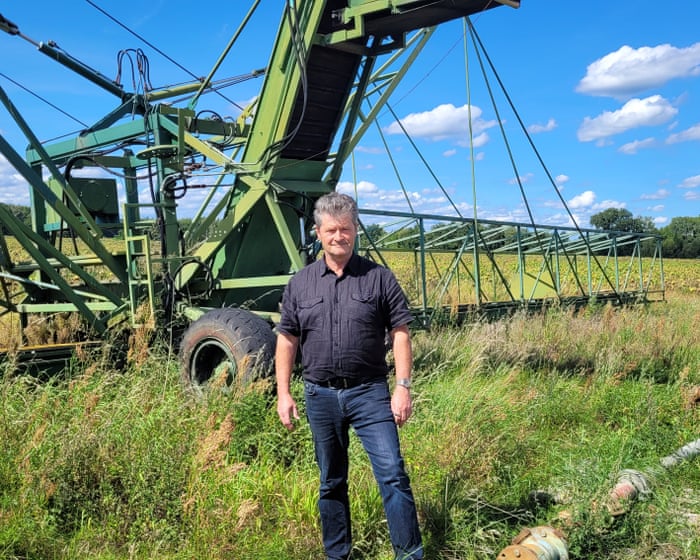Standing by his parched sunflower field, Thomas Goebel crumbled a handful of sandy soil and gestured toward one of the many victims of this year’s drought: a bright green machine that looks like a cross between a tractor and a biplane.
Known as the Gurkenflieger, or cucumber plane, it once moved proudly through his fields with workers perched on its wings, harvesting vegetables to make the sweet-sour-salty Spreewald gherkins. Goebel stopped using it for production five years ago because his pickles couldn’t compete with supermarket prices. A recent experiment offering tourist rides generated excitement but little income.
Now, the Gurkenflieger is among the aging equipment and four hectares of woodland that Goebel has sold to cope with cash flow problems, as bank loans and employee wages clash with unpredictable weather. This year’s drought has devastated his crops, reducing yields to 40-75% of the average over the past two decades.
“It makes your heart race,” said Goebel, who calls himself an optimist and leads the south Brandenburg farmers’ association, referring to the hot, dry conditions that shriveled his plants this year.
“Every day on my way from home to the fields, I had to watch the sunflowers and corn curl up and wither,” he recalled. “I felt like I had to drive with blinders on. I couldn’t bear to look left or right.”
Stories like Goebel’s are increasingly common across Europe. A study earlier this summer found that drought has cost the continent a staggering €11.2 billion (£9.8 billion) annually in recent decades, and losses are expected to grow as fossil fuel pollution fills the atmosphere.
If global warming reaches 2°C (3.5°F) above pre-industrial levels—an optimistic scenario given current policies—annual drought losses in the EU, UK, Norway, and Switzerland are projected to rise to €13 billion (£11.3 billion). Should temperatures hit a catastrophic 3°C (5°F), losses could reach €17.5 billion (£15.3 billion).
The food system is particularly vulnerable. Lilian Guzmán, a farmer near Berlin, reported a “total failure” of her rapeseed crop due to the drought. As harvest time approached, she and her employees anxiously hoped for rain.
“It was incredibly stressful,” said Guzmán, whose sandy soil, like Goebel’s, struggles to retain water. “We were watching from the window like children waiting for the first snowfall.”
Adam Beer, an organic farmer in southwest England, hadn’t seen significant rain for months when he planted cabbages and cauliflowers after the early July heatwave that scorched Europe. He irrigated his field once before and twice after placing the four-inch seedlings into the fragile soil.
But within a week, the young plants had either disappeared or become so dry they could be crumbled to dust. Beer had anticipated losing half his crop to the heat and dryness but instead found 95% destroyed. “Your heart just sinks,” he said. “It’s devastating.”
From the UK, which experienced its driest spring in over a century, to Ukraine—a breadbasket now facing desertification—water shortages are causing pain in lesser-known sectors of the European economy as well.
“It is indeed stressful,” said Martin Staats, head of the German inland shipping association. Low water levels are limiting movement and preventing ships from carrying full loads. During the driest spells, vessels have been forced to remain idle in harbors.
“Compared to Covid or other economic challenges in shipping, drought is the biggest problem,” Staats explained. “It’s unpredictable, unforeseeable, and we can’t adapt our vessels to it.”
The economic impact of drought is most evident on the Rhine, which connects Germany’s industrial core with Rotterdam, Europe’s largest port. In 2018, the river became too warm to cool industrial facilities and supply water.Water levels dropped too low for shipping raw materials or goods, costing German chemical company BASF €250 million (£218 million) in lost production.
Svenja Paul, a financial spokesperson for Covestro, a smaller German chemical firm, noted their losses from that year’s drought were lower—”in the mid-double-digit million-euro range.” She added that the company has invested in measures to avoid “significant disruptions” during recent periods of low water.
“To handle fluctuating water levels, we’ve set up a dedicated taskforce that monitors forecasts and coordinates responses,” she explained. “These include using extra ships, building up stockpiles, and switching transport to rail or road.”
A lone sunflower stands in a field in Brandenburg, Germany, as crop losses across Europe raise concerns about how industries will prepare for future challenges.
Other sectors are also finding it hard to adapt. France and Switzerland had to shut down nuclear power plants during a June heatwave because there wasn’t enough cold water for cooling. Meanwhile, hydropower dams throughout Europe have reservoirs much emptier than last year.
Typically, Europe’s hydropower generation peaks in May with snowmelt and spring rains, but in 2025, output fell to its lowest May level since 2017, according to thinktank Ember. In July, British energy firm SSE cited “unfavorable weather in April and May” for a drop in overall production, including a 40% year-on-year decrease in spring hydropower.
Recent rains have brought relief to some areas, but others remain on alert. By the end of June, one-third of Europe was under orange drought warnings, and by August, red alerts were in effect across large parts of southwestern France and the Balkans.
The drought has put pressure on farmers across the continent, who are already facing other challenges with little flexibility. Svitlana Lytvyn, chief analyst at the Ukrainian Agribusiness Club, described this year’s weather as “particularly disappointing” for Ukrainian farmers. While domestic food needs will still be met, she warned it could lead to a decline in agricultural exports, a crucial part of the war-torn country’s economy.
For Beer, an organic vegetable and crop farmer in England, this year’s losses highlight the need to plan for the future. He estimates the loss of his cauliflowers and cabbages will cost 5-10% of the farm’s annual income, on top of reduced harvests for other crops and expected further losses this winter.
“This means we might have less money to pay ourselves, and definitely less for investments,” he said. “It prevents us from building resilience.”
This article was corrected on 28 September 2025. Temperature increases of 2°C and 3°C correspond to rises of 3.5°F and 5°F, not 36°F and 37°F as previously stated due to an editing error.
Frequently Asked Questions
Of course Here is a list of FAQs about the impact of worsening drought on European farmers designed with clear natural questions and direct answers
General Beginner Questions
1 What does I couldnt bear to watch refer to in this context
Its an emotional quote from farmers describing the heartbreaking experience of seeing their crops fail and die in the fields due to extreme drought after all their hard work and investment
2 Why are European farmers struggling with drought now
Climate change is causing more frequent and intense heatwaves and longer periods with little to no rain leading to severe water shortages that crops and soil cannot withstand
3 What happens to a crop during a severe drought
The plant doesnt get enough water to grow so it becomes stunted withers and can die Even if it survives the yield is drastically reduced and the quality is often poor
4 Which crops are most affected by drought
Crops with high water needs are hit hardest like maize sunflowers sugar beets potatoes and vegetables Even traditionally hardy crops like wheat and barley are suffering
5 How does a lost harvest affect a farmer financially
It can be devastating Farmers invest a lot of money in seeds fuel and fertilizer A failed harvest means no income from that crop making it difficult to pay bills repay loans or invest in the next season
Deeper Advanced Questions
6 Is this just a problem of less rain or are there other factors
Its a combination Less rainfall is the main issue but higher temperatures increase evaporation from soil and plants making the dry conditions even worse In some regions outdated water infrastructure and competition for water resources add to the problem
7 What is soil moisture deficit and why does it matter
It means the soil is much drier than it should be Even if some rain falls it may only wet the surface and not reach the deep roots of plants A deep moisture deficit takes a long time to recover from and affects crops for multiple seasons
8 How does repeated drought affect the soil itself
Prolonged drought can kill the beneficial microbes and organisms that keep soil healthy It also makes soil more prone to erosion by wind and water as theres no plant cover to hold it together




